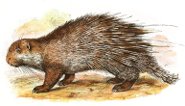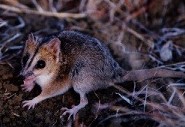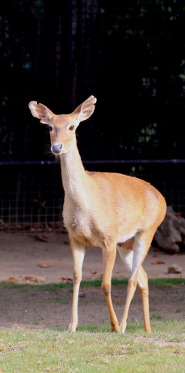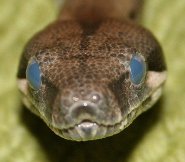Monday 20 February 2012
Thick-spined Porcupine - Adapted to Living Near People

The thick-spined porcupine (
Hystrix crassispinis) is also called the Bornean rattle porcupine. It is one of the few native mammals in Southeast Asia that is not endangered. This large
rodent is often hunted by people for its meat. It lives in the forests, pastures and plantations of the Island of Borneo. It can survive in hilly regions up to 3937 feet (1200 meters) above sea level. It can even live in people’s back yards. Unlike many other native rodents, it seems unconcerned by the spread of man and his farmlands.
They also do well in captivity, provided that they are kept in heated environments with a humidity level kept to at least 35%. Food must be given on the ground or in bowls hard enough to withstand the strong, nearly beaver-like teeth, which grow throughout the porcupine’s life. When they are not eating or gnawing, thick-spined porcupines like to tunnel underground.
Physical Description
Thick-spined porcupines resemble large small-toothed beavers with long toes and pale spines behind the forelegs, up to the middle of the back and down to the tail. Spines, more properly called quills, are modified hairs and made of the same material as hair. Their short fur is brown or grey with a pale underbelly, neck and insides of the legs. Some have small white patches on the body or face. They have small heads in comparison to their body size, with small eyes and rose-petal shaped pale ears. Their narrow tail ends in a club-like clump of quills.
An adult thick-spined porcupine can grow to be 17 inches (43.18 centimeters) long. Quills can grow as long as 7 inches (17.78 centimeters.) Adults can weigh from 3.3 to 6.61 pounds (1.5 to 3 kilograms.) These quills can be raised or voluntarily rustled by the porcupine, making a hissing or rattling noise.
Life Cycle and Behavior
Much of thick-spined porcupine’s behavior is unknown because of their nocturnal lifestyle. Thick-spined porcupines tolerate being near each other, but tend to keep to just mated pairs and offspring. Males help protect babies, but the female does most of the work raising the young. The one to three babies produced stay with their parents from 6 months to one year before going off on their own.
Thick-spined porcupines sleep in underground burrows during the day and come up to feed at night. They eat fruits, vegetables, grains, roots, tubers, cereals and dry pet food. It is unknown what other predators feed on thick-spined porcupines other than people.
You can help spreading the word about this animal by liking it on facebook
Permanent Link
Friday 17 February 2012
Julia Creek Dunnart - Mouse-like Marsupial

The Julia Creek dunnart (Sminthopsis douglasi) shares two features with the vastly different kangaroo – both are marsupials. Instead of developing in a womb, the babies develop in a pouch. Both creatures live in Australia. Unlike the kangaroo, the Julia Creek dunnart is considered endangered under Australian law. Its habitat has been restricted to a small Northeastern portion of Australia called the Mitchell Grass Downs, where a Julia Creek resides. This is an arid environment.
The Julia Creek dunnart was almost wiped out before it was discovered in the 1930. The species was thought to have been wiped out by invasive species such as the
European fox and the domestic cat until it was rediscovered in 1992. Populations have risen slightly since then as
Australia has begun exterminating stray cats. The Julia Creek dunnart is still prey for dingos.
General Description
This little marsupial strongly resembles a mouse, with tiny pink paws and a long, naked tail. Its coat is a light sandy brown with a dark stripe running from the tip of the nose down the spine. The dark eyes are large in comparison to the rest of the head. The belly, chest and inside of the legs are white.
Adults weigh in between 1.41 to 2.47 ounces (40 to 70 grams) and reach a nose to tail length of 6.3 to 9.45 inches (160 to 240 millimeters.) The tail is almost as long as the rest of the body. The Julia Creek dunnart is the largest of the 21 known species of dunnarts or mouse-like narrow-footed marsupials.
Life Cycle and Behavior
After a gestation of a mere 12 days, the females expel the pink embryos, which crawl from the vagina to the pouch. The embryos are so undeveloped that they do not have lungs and absorb oxygen through their skin. A female can have up to eight babies or joeys at a time. Julia Creek dunnarts begin hunting when they are only 10 weeks old. Julia Creek dunnarts live in family colonies and enjoy each other’s company.
Julia Creek dunnarts can take down lizards and mice nearly twice their size. They also hunt spiders and insects. They rarely need to drink because their prey contains the moisture they need. They make their homes deep in crevices in the ground during the day and come up at night to hunt. They can go into a hibernation-like state in order to survive times of famine.
Picture of the Julia Creek Dunnart by ZooPro, licensed under the
Creative Commons Attribution-Share Alike 3.0 Unported license.
You can help spreading the word about this animal by liking it on facebook
Permanent Link
Friday 10 February 2012
Eld's Deer - Magazine Fights to Undo Human's Damage

The eld's deer (
Panolia eldii) is a species of deer that live within Asia. The animal weighs between 270 to 380 pounds (125 - 175 kg) and are typically between 60 to 70 inches long (150 - 180 cm) with males being slightly larger than females. The fur on the eld's deer changes colors with the seasons, turning dark brown in the winter and a dark red in the summer months. The most unique physical feature about this creature, however, are the horns. Unlike other deer horns which grow upwards, the eld's horns grow outwards and inward, resulting in antlers that resemble a half-pipe.
Because the horns of the deer are so unique, the panolia eldii is often hunted by humans who consider the creature prized game. This has resulted in the species becoming extremely threated, ranking "Endangered" on the conservation status scale. Sadly, despite the fact that hunting these animals is illegal, hunters continue to do so, occasionally even sneaking into wildlife preserves to do so. Because there are so few panolia eldi left in existence, this makes
humans their number one predictor.
A well-known Indian magazine for children, known as Chandamama, has taken to fighting for the rights of the eld's deer. In the magazine, stories told from the deer's point of view are featured in an effort to teach young children kindness and understanding towards the animal. The hope is that, if children are taught to respect the creature from a young age, there will be less poachers hunting the panolia eldii in the future.
In the wild, the eld's deer would typically live in dry forest areas and feed upon plants such as grasses, crops, and fruit. Because there are so few eld's deer left, the majority of them reside on wildlife preserves. The Keibul Lamjao National Park in
India has played a key role in bring this species back from the brink of extinction. At the time the species was considered endangered, there were only 14 known living deer. Now, nearly 40 years later, the park has raised that number to nearly 200.
Not all deers are protected however. In Thailand, despite the species being endangered, there are no laws setup in order to protect the eld's deer. This is due to low funding and lack of politicians willing to protect the animal. Many fear that if this doesn't change soon, the eld's deer could become extinct in the very near future.
Picture of the eld's deer by Karelj, licensed under the
Creative Commons Attribution-Share Alike 3.0 Unported license.
You can help spreading the word about this animal by liking it on facebook
Permanent Link
Thursday 02 February 2012
Boa constrictor - Nature's Adapter

The Boa constrictor (
Boa constrictor) is one of the most well known species of snake in the world. This is partly due to the fact that boa constrictors can be found in a wide variety of places, including
Mexico, North America, South America, Caribbean islands, and more. They are also commonly seen at zoos and reptile houses across the world.
The boa constrictor is a large breed of snake, often reaching a weight of 60lb (27kg) in the wild. Female boas are larger than males, at around 10ft (3m) while males average around 8ft (2.5m). In captivity, these creatures have been known to grow even larger since they are well-fed on a regular basis.
The boa constrictor is highly versatile and adapts well to any living situation. Everything from the food they eat to the places they live are determined by their living environment. Ideally, the boa constrictor lives in the rain forest where it can camouflage itself within the trees and bushes, however this species has also been known to live in the desert or by oceans and lakes as well. When living in the desert, they often seek refuged deep within animal burrows, and while living by the water they tend to nest near the shore.
The boa constrictor's diet depends greatly on where it's living, but always consists of small animals. The snake will camouflage itself waiting for an animal to pass. Once one does, the boa strikes, biting it several times before constricting the creature until dead. Then the snake begins the process of digesting it, which can take up to a week. Mice, lizards and other small mammals are often consumed if the snake is living in the desert, while, and bats and birds are consumed if living in the rain forest. If the boa is living by water, they often use their outstanding swimming abilities to hunt amphibians found within the water. As the boa grows, the size of the prey goes up as well. It's not uncommon to see an adult bow constrictor hunting rabbits or wild chickens.
Young boa constrictors have many predators, including wild pigs, hawks,
coatis, and caimans. The adult boa's main predator is the
human, who hunt the snake for it's meat and skin. Because of this, the boa constrictor is listed as "Vulnerable" on the conservation status scale. This means that while the species isn't endangered currently, they are at a high risk of becoming so if special steps are not taken to protect this species.
Picture of the Boa Constrictor by XPS420, licensed under the
Creative Commons Attribution-Share Alike 3.0 Unported license.
You can help spreading the word about this animal by liking it on facebook
Permanent Link
 The thick-spined porcupine (Hystrix crassispinis) is also called the Bornean rattle porcupine. It is one of the few native mammals in Southeast Asia that is not endangered. This large rodent is often hunted by people for its meat. It lives in the forests, pastures and plantations of the Island of Borneo. It can survive in hilly regions up to 3937 feet (1200 meters) above sea level. It can even live in people’s back yards. Unlike many other native rodents, it seems unconcerned by the spread of man and his farmlands.
The thick-spined porcupine (Hystrix crassispinis) is also called the Bornean rattle porcupine. It is one of the few native mammals in Southeast Asia that is not endangered. This large rodent is often hunted by people for its meat. It lives in the forests, pastures and plantations of the Island of Borneo. It can survive in hilly regions up to 3937 feet (1200 meters) above sea level. It can even live in people’s back yards. Unlike many other native rodents, it seems unconcerned by the spread of man and his farmlands.
 The Julia Creek dunnart (Sminthopsis douglasi) shares two features with the vastly different kangaroo – both are marsupials. Instead of developing in a womb, the babies develop in a pouch. Both creatures live in Australia. Unlike the kangaroo, the Julia Creek dunnart is considered endangered under Australian law. Its habitat has been restricted to a small Northeastern portion of Australia called the Mitchell Grass Downs, where a Julia Creek resides. This is an arid environment.
The Julia Creek dunnart (Sminthopsis douglasi) shares two features with the vastly different kangaroo – both are marsupials. Instead of developing in a womb, the babies develop in a pouch. Both creatures live in Australia. Unlike the kangaroo, the Julia Creek dunnart is considered endangered under Australian law. Its habitat has been restricted to a small Northeastern portion of Australia called the Mitchell Grass Downs, where a Julia Creek resides. This is an arid environment. The eld's deer (Panolia eldii) is a species of deer that live within Asia. The animal weighs between 270 to 380 pounds (125 - 175 kg) and are typically between 60 to 70 inches long (150 - 180 cm) with males being slightly larger than females. The fur on the eld's deer changes colors with the seasons, turning dark brown in the winter and a dark red in the summer months. The most unique physical feature about this creature, however, are the horns. Unlike other deer horns which grow upwards, the eld's horns grow outwards and inward, resulting in antlers that resemble a half-pipe.
The eld's deer (Panolia eldii) is a species of deer that live within Asia. The animal weighs between 270 to 380 pounds (125 - 175 kg) and are typically between 60 to 70 inches long (150 - 180 cm) with males being slightly larger than females. The fur on the eld's deer changes colors with the seasons, turning dark brown in the winter and a dark red in the summer months. The most unique physical feature about this creature, however, are the horns. Unlike other deer horns which grow upwards, the eld's horns grow outwards and inward, resulting in antlers that resemble a half-pipe. The Boa constrictor (Boa constrictor) is one of the most well known species of snake in the world. This is partly due to the fact that boa constrictors can be found in a wide variety of places, including
The Boa constrictor (Boa constrictor) is one of the most well known species of snake in the world. This is partly due to the fact that boa constrictors can be found in a wide variety of places, including